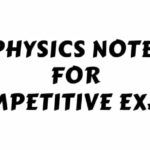Last updated on February 20th, 2019 at 01:14 pm
Physics Notes for Competitive Exams
SOUND
Sound is form of energy emitted by the vibrating particles and propagates in form of waves in all possible directions.
Sound neither be generated nor propagated in vacuum where material medium is absent.
This phenomenon is proved by Robert Boyle with glass jar experiment.
Robert Boyle is also known as father of Chemistry.
Note:
1 Speed sound is zero in free space i.e., v = 0
2 Electromagnetic waves requires no medium
3 If Atom bomb exploded in moon, sound cant be heard
4 If bullet fired in moon,sound cant be heard
5 Scientific name of moon is selene and its study selenology
6 1st man to land on moon is armstrong by Apolo 11, the place wherer he landed on surface of moon is called sea of tranquility
7 Moon stands on the 5th position according to size
Limits of Audibility
In general, humans hears from 20hz – 20,000hz(20khz) such waves are called as audible waves
The Inaudible wave beyond 20hz is infrasonic and ultrasonic.
Infrasonic sound
Infrasonic waves propagates only through surface of the Earth.The snake on the soil and whale on the sea can hear infrasonic sound.
Infrasonic sounds are produced during
1 Explosion of Atom bomb.
2 Earth quake.
3 Thunders.
4 Heavy vehicle traveling on road.
Ultrasonic sound
Ultrasonic waves can be generated in labs by piezoelectric effective method. These waves can be received(heard) by dogs(50000hz), bats, tortoise, dolphins(1 lakh hz)
Note
1 Ultrasonic waves are used to kill bacteria in the water and milk
2 Processing of soldering of two wire, soldering materials contains Lead and Tin.
3 To scatter the mosquitoes, these waves are used
4 To attract fishes(fishing)
5 To identify the potential fisher zone in sea
6 To crush the stones formed in the kidenys
7 To Scan the internal organs of the body(Ultrasonography)
8 They are used in the treatment of Arthritis
9 To Remove the broken teeth without any pain
10 They are used in the working of SONAR( sound navigation and ranging), SONAR invented by Nixon , it is used to determine the depth of sea and to locate the positions of submarines
11 To drill holes in the hard materials like Metals, alloys etc,
12 To detect the position of the cracks formed inside the metal plate
Waves
Wave is nothing but energy carrier.
Characteristics of wave
Amplitude
Wavelength
Time period
Frequency.
Amplitude
The maximum displacement of the vibrating particles from its mean point is known as amplitude
In other words, the maximum displacement of the oscillating pendulum from its mean to any extreme point is called amplitude.
Units of Amplitude are mm, cm, mts(international unit)
Wavelength(λ)
The distance between any two successive compression and rare fractions are called as wavelength.
Units of wavelength are mm, cm, mts
But the smallest unit is to measured wavelength is angstrom = 10⁻¹⁰m.
Time period
The time required to complete one oscillation or one vibration is called as Time Period.
Units of time period are sec, min, hrs, days, years etc
Frequency
The number of vibration per second of vibrating body is called as frequency.
Units of Frequency is cycle/second
Hertz(hz) is international unit of Frequency
1 Khz = 1000 hz (10³hz)
1 Mhz = 10⁶ hz
1 Ghz = 10⁹ hz
Depending on the nature, waves are classified into 2 types
Mechanical waves
Electromagnetic waves.
Mechanical waves
The waves requires a material medium for the propagation, hence they cannot propagate in the vacuum or free space.
Ex: Sound waves.
Electromagnetic Waves
These waves does not require any material medium for the propagation, they can travel in presence or absence of material medium
Ex: light
Depending on modes of propagation, waves are further classified into 2 types.
Longitudinal waves.
Transverse waves.
Longitudinal Waves
Longitudinal waves advances in the form of compression and rare fractions which are formed alternatively
Compression is a point where the density of the vibrating Air molecules is Maximum and Rare fraction is Minimum.
Ex: Sound waves in the air
Transverse waves
The Maximum amplitude of energy at the crest and Minimum at the trough.
Ex: sound waves in liquids and solids
Light waves
Light waves propagates in the form of transverse waves in all the medium. Like water, glass, air.
Progressive waves
The wave which advances to the infinite distance without being either reflected or abstracted is called as progressive waves.
In such waves the magnitude of amplitudes remains same at all points.
If the amplitude of wave decreases with respect to time then it is called as Damping waves(Dying of waves).
Stationary wave (standing waves)
If either two longitudinal or transverse waves having same amplitude,wavelength, frequency travel in the opposite directions then they superimpose on each other and the resultant wave formed in this case
is called as Stationary or standing waves
Stationary wave does not carry the energy from one point to another point
If a wave travels from one medium to another medium then amplitude,wavelength,velocity,intensity etc may change but the frequency of the wave remain same.
Properties of the sound
Resonance
When two bodies having the same frequency and if 1st body is set into vibrate then the 2nd body is began to vibrate with maximum intensity of sound.
This phenomenon is called resonance.
In the Phenomenon of resonance,the natural frequency of two bodies should be equal.
Same frequency – its called resonance
Different frequency – its called forced frequency
Note:
1. When the army men approach a smaller bridge in march fast state then there are asked to step down their march fast to avoid the collapse of the bridge due to the resonance
2. The working of whistle and transistor are based on the principle of resonance of the sound
3. If the speed of the vehicle exceeds certain limit then the phenomenon of resonance takes places between the sound notes of engine and vibrating body of vehicle. Such sound is called Rattling of sound
4. If a sound note with a frequency equal to the frequency of the glass plate is propagated toward it then it breaks into pieces due to the phenomenon of resonance
Echo (Resound)
The reflection of sound wave by reflect of surface is called as echo or resound.
The following conditions should be satisfies to hear echo
1. Time internal between 1st sound and 2nd sound should at least 1/10th of second
2. The separation distance between the source of the sound and reflector surface be 16.5 mts
t = 1/10 sec
d= 16.5 mts
Note:
1. The phenomenon of echo is used to determine the depth of a well. valley, mine etc.
2. This property is used to determine the separation distance between any two big buildings or hills
3. The stethoscope works in the property of reflection of sound
4. Tuning fork is an instrument which vibrates with constant frequency
Learn More
Link 1 – Latest Central government Jobs 2019
Link 2 – 1000+ MCQ Bits
Link 3 – Complete Gk Gs for Competitive Exams
Link 4 – Indian Constitution Notes for competitive Exams
Link 5 – Banking Awareness MCQ Question and Answers
Link 5 – Top Books for Competitive Exams
Link 6 – Download Quantitative and Aptitude Competitive Exams
Related search:
physics general knowledge, physics gk notes for exams, physics gk for competitive exams, physics pdf sound notes, physics sound bit bank, physics sound material for exams, physics sound material pdf, physics gk, physics general knowledge, physics general knowledge pdf, physics general knowledge online, physics general knowledge sound, physics general knowledge in English, physics general knowledge in theory, physcs gk, physics in theory, MCQ sound gk, physics general knowledge, physics general knowledge questions, physics gk notes, physics notes for exams, physics notes for competitive preparation, Physics general knowledge Notes material

